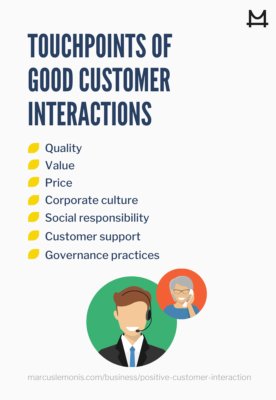Customers today have purchasing power like never before, which is why good customer interaction skills can make or break a brand. It’s no longer just about how much a customer can buy; their power lies more in having control over what, where, why, and how they shop. What’s even more significant is that consumers now also have the power to influence other (potential) consumers, becoming critics and sharing their opinions all over the online landscape.
A customer may purchase one electric toothbrush over another simply because they can have it delivered to their home the next day. They may choose one web hosting company over another because of their customer support reputation. They may schedule an appointment with a particular dentist because he or she offers a great loyalty program. And on and on.

With an overwhelming amount of options, price is no longer the main defining factor for purchasing a product or service. Understanding the best practices for how to interact with customers also comes into play. As Marcus says, “If you have a good relationship with clients, people for the most part will stop shopping on pennies.” Thanks to a highly competitive market no longer dominated by big brands, businesses in the 21st century have to surpass expectations on every level. That’s why good customer interaction skills are a must for virtually any employee.
From quality, value, price, corporate culture and social responsibility, to customer support and governance practices and more— good customer interaction at every touchpoint is key. In fact, according to the Harvard Business Review, Fortune Global 500 firms spend around $20 billion a year on corporate social responsibility activities. So how do you ensure every customer interaction with your business is positive? Let’s take a closer look at good customer interaction skills and the ways to make them part of your company’s culture.


1. Be Transparent
Countless businesses highlight transparency as one of their core values; but being transparent is more than just a buzzword. It’s about good customer interaction skills like always being upfront with customers and not hiding anything. Being transparent means itemizing your service fees so customers know exactly what they’re paying for. Throw out the fine print!

Transparency is taking responsibility for a mistake and explaining how you’re going to fix it. It means leaving up bad reviews on your website and investigating further what went wrong. Maybe there’s a way to make it up to customers. Being transparent really goes a long way, differentiating your business and making sure no one feels taken advantage of, for long-term good customer interaction.
2. Interact And Communicate
When asked how to interact with customers, Fortune 500 company executives list a number of ways to do so, each with their own benefits that even crossover to internal insights such as revamping a marketing or sales strategy. Communicating with a customer in this digital era comes in all shapes and forms. Think community building, social media, email campaigns, live chat, webinars, newsletters, contact forms, phone calls, how-to videos, FAQs, and the like.

When thinking about how to interact with customers, it’s important to note that communication with customers includes before, during, and after your sale. Following-up, checking-in, asking for feedback through a survey, asking for a referral, posting educational blogs, offering a coupon, and sending a note are all ways to communicate post sale. According to Entrepreuneur.com, repeat customers spend 67% more (on average) than new customers. Good customer interaction skills really make a difference!
3. Show Customer Appreciation
Everyone likes to feel appreciated. Consumers are no different. As Marcus likes to say, “There is no being generous to a fault. Because there is no fault in being generous.” Consumers have plenty of choices, and as they get more empowered and connected, their decision-making becomes more complex. Showing a token of appreciation to your customers can go a long way to differentiate your company from the next one.

There are various ways to show your customers you truly appreciate them for choosing your brand, product or service. And saying thank you is a substantial part of good customer interaction. A skincare company can add a face cream sample to a customer’s order. An insurance company can send a card on a customer’s birthday. An online vehicle registration company can add a yearly service reminder to a customer’s profile. From free upgrades and coupons to thank you notes and early access to sales, even a simple handshake, are all ways to make your customers feel they are getting VIP treatment. You can truly inspire more loyalty and get repeat business by just showing a little bit of gratitude. Remember, good customer interaction skills need practice!
4. Resolve Problems Quickly
Interacting with customers successfully includes the issue of, well, issues. The more you grow as a company, the more exposure you’ll have, making your brand more vulnerable. Good customer service goes beyond fixing problems though, it’s about anticipating them and having solutions that can turn bad customer experiences around fast. Be prepared to nip problems in the bud and contact customers to resolve issues that have already occurred as soon as possible. That’s good customer interaction! The key is to be proactive and standardize business practices that can even turn issues into opportunities.

For the CEO of a Seattle-based call analytics public company, resolving problems is top of mind and all about good customer interaction. In a Forbes article, he shares his advice for turning mistakes into opportunities saying, “Ask for feedback—from your team, your boss, your clients, anyone. Every bit of feedback, good or bad, pushes us to ask how can we do better? And at the end of the day, this question is what will breed growth and lessons learned from our mistakes or failures. Always ask how you can do better and you will always continue to do better.”

5. Show Empathy
Just like showing appreciation, showing understanding and compassion is just as important. Sometimes good interaction skills just mean lending someone your ear or letting them vent. Don’t just see them as a customer with a problem, see them as a valued partner. That may mean that a nurse spends extra time with his/her patient as he/she shares a personal story, whether or not it is relevant to the patient’s treatment.
When it comes to tips on how to interact with customers, showing empathy is a winner! It can be just acknowledging a customer’s frustration on the phone and simply responding with, “I can see why that made you angry.”
Align yourself with your customer, listen actively to build a rapport, and reassure them. They are the lifeblood of your business after all. They need to feel respected and heard.

6. Make Interactions As Easy As Possible
Whatever industry you’re in, convenient, easy and smooth interactions with customers work best. Every dialogue, across interactions and transactions, should be consumer-friendly for true good customer interaction. For example, redesign your website’s “contact us” page so it’s easier to find or add a map for directions. Another example is adding several payment methods such as all credit cards and digital wallets, or even accepting payment plans.
Amazon founder and CEO, Jeff Bezos, once said, “We are never competitor based or obsessed. We are always customer based and obsessed. We work in a backward workflow. We always begin with our customer needs and then build the framework.” That’s what you call good customer interaction!
7. Promote Customer Loyalty
Listen to customers’ feedback as you continue branding your company so that your business is always relevant and aligned with your target audience. By knowing your customers, you can improve on how to interact with customers. Your customers should have a direct link to providing their opinions, observations and complaints, and sharing ideas on improvement.

You can have a focus group, try pilot programs or beta testing, or create campaigns for new product ideas, like Starbucks has done in the past.
According to the HBS Digital Initiative, in 2008, “My Starbucks Idea” was launched to increase the focus on what customers want. By 2013, the coffee giant had generated over 150,000 ideas from consumers and actually created 277 of those ideas. Starbucks Cake Pops, Hazelnut Macchiato, and free Wi-Fi were all thought of by the general public, not the corporation.
8. Empower Customers
Starbucks isn’t the only corporation empowering customers by giving them a forum to share thoughts, concerns, and engage more with the brand. The LEGO Group also joined in for answers on how to create a more sustainable future.

CEO Niels B. Christiansen said: “As a company who looks to children as our role models, we are inspired by the millions of kids who have called for more urgent action on climate change. We have received many letters from children about the environment asking us to remove single-use plastic packaging.”
Empowering customers for the LEGO Group led to a $400 million investment over three years to accelerate sustainability and social responsibility initiatives. Empowering customers empowers businesses.
9. Understand Customers’ Expectations
If your brand makes promises, you better make sure your business delivers. When honing how to interact with customers, you want to align every expectation with its own response. If your website boasts a two-day delivery, but due to backlogs with the third-party shipment company you employ, you know that now it will take two weeks, you want to make sure you advertise that on your webpage or even social media. Having good customer interaction skills means managing expectations, being realistic and communicating frankly with customers so they can act or react appropriately. That’s good customer interaction.
10. Cultivate A Good Culture
Corporate culture is not only internal, it carries over to customers too. It’s important to identify your own version of customer-first culture, so your employees and/or colleagues can be on the same page. Show how the various functions and operations of the company are impacted by a customer-centric strategy. For example, how are processes or timelines prioritizing consumers? You want excellent champions for your company’s values and beliefs, so your various teams can keep improving interactions across all touchpoints for long-term good customer interaction.
When it comes to how to interact with customers, every business has its own unique formula, depending on their industry, size, and goals. But the fundamentals of good customer interaction are all the same. Appreciate your customers, be honest with them, address concerns, resolve issues quickly, and keep them engaged with your brand. After all, they’re your partners in success.


- How are you going to maintain positive customer interactions?
- What ways do you try to understand your customer expectations?
Morin, A. (2016, April 21). 10 CEOs offer their best advice for turning mistakes into learning opportunities. Retrieved from https://www.forbes.com/sites/amymorin/2016/04/21/10-ceos-offer-their-best-advice-for-turning-mistakes-into-learning-opportunities/#1cb45d674eb2
Grills, J. (2018, April 5). 5 customer care philosophies you should learn from Jeff Bezos. Retrieved from https://www.carlajohnson.co/5-customer-care-philosophies-you-should-learn-from-jeff-bezos/
Lego.com. (2020, September 14). LEGO Group to invest up to US$400 million over three years to accelerate sustainability efforts. Retrieved from https://www.lego.com/en-my/aboutus/news/2020/september/sustainability





